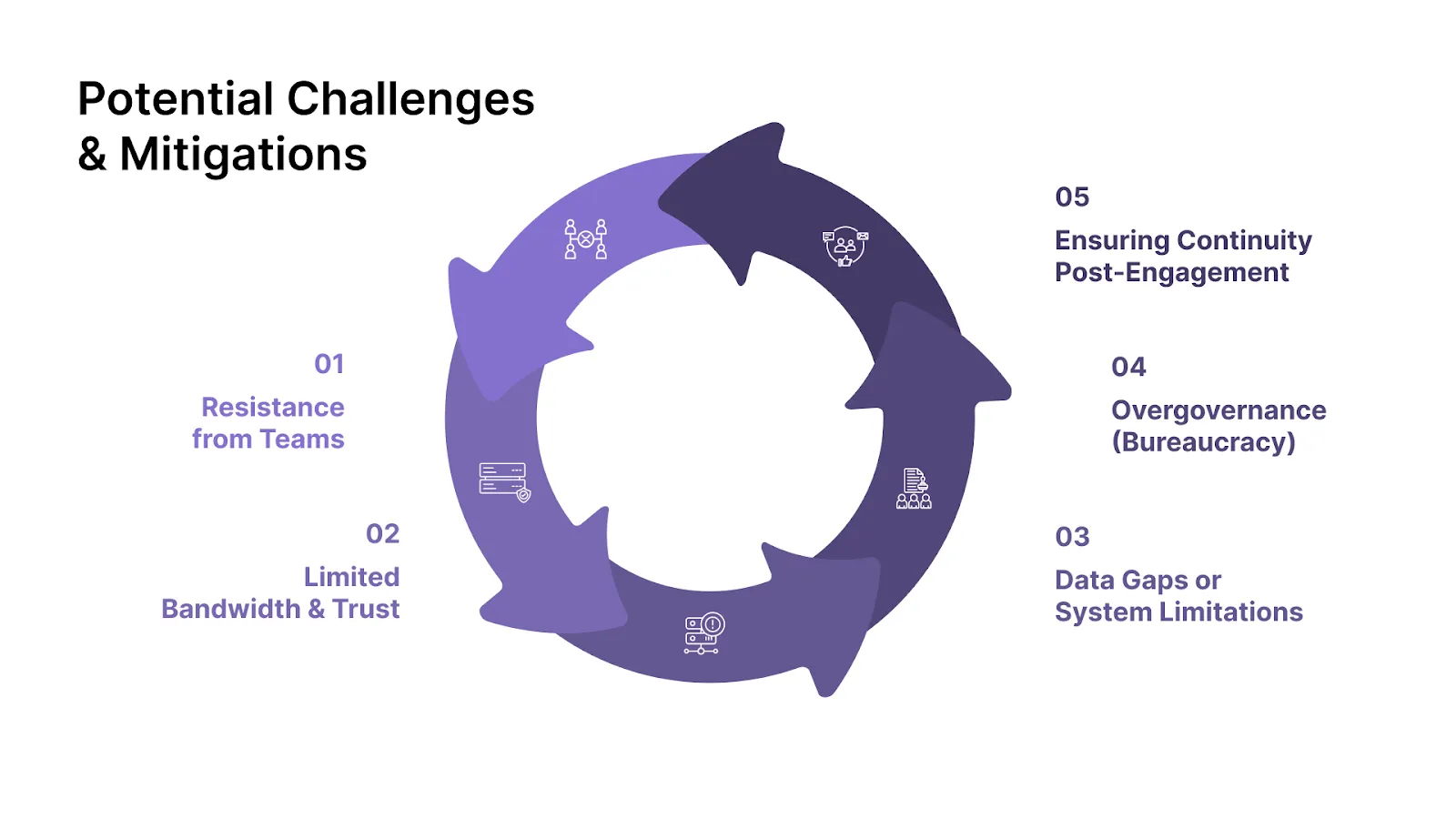Oct 13, 2025
Fractional Chief Revenue Officer: Key Business Impacts

By Fraxtional LLC

As businesses strive to scale efficiently while maintaining control and compliance, many are choosing fractional Chief Revenue Officers (CROs) to lead their growth initiatives. A Fractional CRO brings executive-level expertise to unify sales, marketing, and customer success under one cohesive revenue strategy, driving sustainable performance without the expense of a full-time hire.
According to the 2024 State of Fractional Sales Leadership Report by Vendux, the average monthly fee for fractional sales leaders rose to $9,651, and hourly rates increased to $213.
Key Takeaways
- A Fractional CRO offers strategic revenue leadership without the cost of a full-time executive, focusing on governance, gap analysis, and control testing.
- Their primary role is to unify revenue functions, sales, marketing, and customer success under a cohesive strategy.
- Key activities include identifying revenue leaks, establishing decision rights, and validating systems to reduce risk and ensure compliance.
- This approach enables organizations to scale efficiently while maintaining accountability and transparency.
- Effective governance and control frameworks built by Fractional CROs foster long-term, sustainable growth and stakeholder confidence.
The real advantage of a Fractional CRO lies in its ability to identify revenue gaps, establish governance, and implement control testing to ensure sustainable performance and investor confidence.
This article examines how these three pillars help organizations achieve scalable, compliant, and data-driven growth.
What is a Fractional CRO?

A Fractional Chief Revenue Officer (CRO) is a part-time executive who oversees all revenue-generating functions, sales, marketing, partnerships, and customer success. Unlike short-term consultants, they integrate into the leadership team to align day-to-day operations with the long-term growth strategy.
This model allows startups, scaling companies, and private equity–backed firms to access senior-level expertise without the expense of a full-time hire. A Fractional CRO builds the infrastructure for sustainable revenue growth, optimizing processes, enforcing governance, and fostering accountability across teams to ensure predictable, data-driven performance.
Why Gap Analysis, Governance, and Controls Matter
While many organizations bring in Fractional CROs to fix sales or marketing inefficiencies, the most successful engagements go deeper, addressing the underlying structure of revenue management.
- Gap analysis identifies areas where revenue leakage occurs, whether through process inefficiencies, data gaps, or misaligned incentives.
- The governance structure establishes clear decision rights, reporting lines, and accountability, ensuring that every team operates under unified revenue goals.
- Control testing validates that processes and policies are functioning as designed, minimizing financial, operational, and compliance risks.
Together, these pillars turn reactive operations into proactive, compliant systems, enabling confident, disciplined, and scalable growth.
How a Fractional CRO Differs Strategically
A Fractional CRO bridges the gap between full-time and interim leadership, offering strategic oversight with flexibility and cost efficiency.
Unlike a full-time CRO, who manages all revenue functions as a permanent executive, or an interim CRO, who maintains stability during transitions, a Fractional CRO focuses on targeted growth areas, from refining sales processes to strengthening governance and performance controls.
Their experience across multiple organizations provides them with a broader, more objective perspective, enabling them to design scalable frameworks rather than quick fixes.
While tactical consultants address immediate problems, strategic Fractional CROs embed governance, accountability, and measurable control systems into the company’s revenue engine, creating sustainable, compliant growth that endures long after their engagement ends.
The Impact of Fractional CROs on Businesses

A Fractional CRO unites sales, marketing, and customer success under one growth strategy. They provide high-level revenue leadership and structure, driving scalable results without the cost or commitment of a full-time executive.
Core Responsibilities & Scope
Bridging Revenue Functions
A Fractional CRO unites all revenue functions under a single strategy, creating shared KPIs and streamlined workflows to eliminate silos, enhance collaboration, and improve conversion efficiency.
Diagnosing Revenue Gaps
They assess sales funnels, marketing performance, and retention metrics to identify inefficiencies, optimize processes, and strengthen scalability through data-driven insights and operational improvements.
Operating with Agility and Impact
Working part-time, Fractional CROs deliver executive-level results efficiently, accelerating pipeline velocity, improving forecasting accuracy, and building scalable, results-focused revenue systems across teams.
When do Organizations Hire a Fractional CRO
When Growth Stalls
Fractional CROs step in when revenue plateaus, diagnosing gaps and realigning operations for predictable, sustainable growth.
During Transitions
They bridge critical phases, post-funding, pre-M&A, or pre-hire, stabilizing operations and building governance for scalable success.
In essence, a Fractional CRO provides the strategic leadership and structural alignment needed to drive sustainable growth. By unifying teams, strengthening governance, and optimizing performance, they help organizations scale efficiently and confidently.
Suggested Read: The Risk Assessment Process in Fintech: A Step-by-Step Overview
Fractional CRO Gap Analysis

A Fractional CRO gap analysis is a structured diagnostic approach used to evaluate the health of a company’s revenue ecosystem, encompassing marketing and sales, customer success, and renewal operations.
Purpose & Benefits
A well-executed gap analysis provides measurable clarity across the organization’s revenue model.
- Identify where revenue leaks, inefficiencies, and misalignments exist. The analysis reveals pain points across funnel stages, team interactions, pricing strategy, and customer retention.
- Provide a structured roadmap for remediation. Findings are translated into a clear action plan that defines ownership, timelines, and measurable performance outcomes.
By integrating these insights into strategic planning, companies not only improve operational visibility but also enhance forecasting accuracy and investor confidence.
Key Dimensions / Areas to Analyze
A Fractional CRO evaluates multiple dimensions within the revenue organization to uncover systemic and procedural inefficiencies.
Funnel & Pipeline Health
Evaluating the sales funnel and pipeline integrity is central to any gap analysis. The Fractional CRO assesses lead quality, conversion rates, and deal velocity to identify where prospects drop off, recommending process or system improvements to strengthen conversion consistency.
Sales Process Integrity
A clear and consistent sales process is vital for predictable growth. The Fractional CRO standardizes stage definitions, qualification criteria, and deal management practices to ensure visibility, accuracy, and accountability across the sales pipeline.
Metrics & Reporting Consistency
Reliable data governance underpins effective revenue leadership. The Fractional CRO establishes unified dashboards and performance metrics, covering pipeline health, win rates, CAC, and LTV, to eliminate blind spots and improve decision-making accuracy.
Incentive & Compensation Alignment
Misaligned incentive plans can lead to short-term gains at the expense of sustainable growth. The Fractional CRO reviews and redesigns compensation structures to align rewards with long-term revenue goals, customer retention, and overall organizational health.
Cross-Functional & RevOps Alignment
Cross-functional misalignment often hinders growth. The Fractional CRO unites marketing, sales, customer success, and RevOps under shared KPIs and continuous feedback loops, ensuring end-to-end collaboration that drives consistent and predictable revenue performance.
Methodology
A disciplined methodology ensures that the gap analysis is actionable rather than theoretical.
- Discovery: conduct stakeholder interviews, review historical performance data, and audit systems such as CRM, marketing automation, and customer success platforms.
- Benchmarking: Compare existing performance against industry best practices and peer organizations to identify areas for improvement and competitive gaps.
- Gap Prioritization: Classify findings by impact and ease of remediation, ensuring resources are focused on initiatives that drive the most significant ROI.
- Deliverables: Present a Gap Map, Quick-Wins Plan, and a Strategic Roadmap outlining next steps, metrics, and ownership across functions.
This structured cadence allows leadership to make informed, data-driven decisions that improve both efficiency and accountability.
Examples
Example 1:
A Series B FinTech firm experiencing stagnant pipeline growth engaged a Fractional CRO to conduct a 6-week gap analysis. The review revealed redundant lead handoffs between marketing and sales, resulting in a 22% drop in conversions.
Streamlined lead routing and redefined qualification criteria increased conversion efficiency by 17% within one quarter.
Example 2:
A SaaS company with inconsistent quarterly forecasts underwent a metrics audit led by a Fractional CRO.
The analysis identified conflicting data sources between CRM and finance systems. Implementing unified dashboards and standardized reporting improved forecast accuracy by 28% and restored board confidence.
These examples underscore that a Fractional CRO’s gap analysis is not merely diagnostic; it is transformative, turning operational noise into clear, actionable insight for revenue optimization.
Suggested Read: Understanding Audit Procedures and Controls
Fractional CRO Governance Structure

A governance structure is the backbone of sustainable revenue leadership.
For a Fractional CRO, which often operates in a part-time or advisory capacity, strong governance ensures consistency, accountability, and transparency across all revenue-generating functions.
Purpose & Benefits
Effective governance transforms revenue operations from reactive to proactive.
- Governance defines roles, decision rights, and approval paths, reducing ambiguity and ensuring accountability across all revenue functions.
- It eliminates overlap between teams, aligning sales, marketing, finance, and success around one unified strategy.
Strong governance enables fast, informed decisions while maintaining structure and consistency across the organization.
Elements of a Strong Governance Framework
A well-structured governance model serves as the operating manual for how revenue decisions are made and enforced.
Roles & Decision Rights
Clear decision ownership defines who approves pricing, discounts, and pipeline updates, ensuring accountability and preventing delays or unauthorized actions.
Escalation Paths & Exception Handling
Defined escalation processes resolve stalled deals, pricing exceptions, and disputes quickly while maintaining operational discipline and compliance standards.
Cadence and Meeting Forums
Regular deal reviews, forecast sessions, and revenue meetings align teams on performance, risks, and opportunities, supporting consistent strategic execution.
Documentation & Change Management
Centralized policies, playbooks, and process updates ensure continuity, consistency in training, and audit readiness across all revenue operations.
Performance Review Loops and Feedback Cycles
Regular performance reviews track KPIs, identify weaknesses, and drive continuous improvement through transparent communication and actionable insights.
Best Practices Drawn from Governance in Adjacent Fields
Lessons from regulated sectors, such as clinical research and financial services, underscore the importance of precise governance.
ClinicalLeader’s “6 Rules for Establishing Bulletproof CRO Governance” emphasizes that robust governance frameworks rest on apparent decision authority, documented policies, and systematic oversight.
A Fractional CRO can adapt these principles by:
- Formalizing decision hierarchies early in engagement.
- Implementing documentation standards for all revenue-critical processes.
- Ensuring auditability through routine process verification and compliance reviews.
Tailoring governance based on organizational maturity is equally critical.
Startups may require lightweight governance that emphasizes agility, while mid-market and regulated firms need deeper controls, policy enforcement, approval logs, and cross-departmental review cycles to ensure long-term scalability and compliance.
Through structured governance frameworks, Fraxtional helps organizations eliminate revenue bottlenecks and strengthen decision-making clarity across departments.
Fractional CRO Control Testing & Assurance

Control testing and assurance are essential components of a Fractional CRO’s toolkit.
In revenue operations, where small process failures can lead to significant financial or compliance risks, structured control testing ensures that systems, approvals, and reporting mechanisms work precisely as intended.
What Is Control Testing in Revenue Operations
Control testing refers to the validation of key operational and financial processes that directly impact revenue accuracy and the integrity of reporting. This involves confirming that established controls, such as deal approval thresholds, pricing governance, and data validation rules, are functioning as designed.
For example, a control test may verify whether:
- All sales discounts receive appropriate managerial approval.
- Deal approvals follow the proper authorization workflow.
- CRM data integrity ensures that accuracy and completeness standards are met.
In short, control testing provides leadership with assurance that revenue processes are both practical and compliant, thereby reducing the risk of misreporting or operational breakdown.
Why it Matters in a Fractional CRO Engagement
For a Fractional CRO, control testing is more than a compliance activity; it is a strategic assurance mechanism that safeguards the integrity of the company’s growth engine.
- Prevents Revenue Leakage & Ensures Compliance
Regular control testing detects gaps early, protecting revenue integrity and maintaining compliance, critical for regulated sectors like FinTech and SaaS. - Builds Stakeholder Confidence
Documented controls and transparent testing reassure investors and boards that revenue operations are stable, compliant, and audit-ready.
By embedding control testing within recurring reviews, a Fractional CRO strengthens both governance maturity and organizational trust.
Suggested Read: Comprehensive Guide to Fractional Support and Its Benefits
Types of Controls & Areas to Test
Control testing spans multiple operational layers within revenue management. Each layer is critical to maintaining financial accuracy and procedural integrity.
Process Controls
These ensure operational consistency in daily activities, such as:
- Discount approvals – Validating compliance with pre-set pricing policies.
- Pricing overrides – Confirming that exceptions are properly authorized.
- Segmentation enforcement – Ensuring territories and customer segments are respected in the sales process.
Data Quality Controls
Accurate data underpins every revenue decision. Controls here focus on:
- CRM hygiene – Removing duplicate or incomplete records.
- Forecast validity – Verifying that deal data accurately reflects sales progress.
- Duplication checks – Preventing redundant opportunities or customer records that distort reporting.
Segregation of Duties, Audit Trails, and Authorization Logs
These controls prevent conflicts of interest and enforce accountability. For instance, no single individual should have the authority to both create and approve deals. Audit trails and logs ensure traceability of every transaction or approval event.
Exception Handling & Remediation Controls
Controls in place ensure that exceptions, such as manual invoice adjustments or unapproved pricing, are logged, reviewed, and remediated in a timely manner. They maintain discipline without stifling flexibility.
Testing Methodologies & Frequency
A Fractional CRO typically employs several methodologies to ensure rigorous control testing and reliable assurance:
- Sample-Based Testing: Randomly selecting transactions or records to verify adherence to policy.
- Walkthroughs: Observing real-time process execution to confirm that steps align with documented procedures.
- Root-Cause Analysis: Investigating recurring control failures to uncover systemic issues rather than surface-level errors.
- Ongoing Monitoring & Continuous Audits: Implementing dashboards or automated alerts to track compliance metrics and flag anomalies in real time.
- Re-Testing: Conducted after remediation efforts to confirm that gaps have been successfully addressed.
Frequency depends on business complexity and risk exposure. High-growth or regulated firms may conduct quarterly tests, while smaller organizations may conduct semiannual tests.
How Results Feed Back Into Governance and Gap Remediation
The output of control testing doesn’t end with a report; it actively informs continuous improvement across the revenue organization.
- Use control failures as insights
Each weakness informs process, policy, or system improvements.
- Refine governance and incentives
Update rules, training, and rewards to strengthen compliance and accountability.
A robust control testing and assurance framework transforms revenue management from reactive oversight into proactive leadership.
Companies partner with Fraxtional to establish governance frameworks that align cross-functional teams under clear decision rights and performance standards.
Business Impacts & ROI of Integrating Gap, Governance & Controls
When a Fractional CRO integrates gap analysis, governance, and control testing, the result extends far beyond efficiency; it drives measurable, sustainable growth.
These frameworks create proactive revenue leadership built on accountability, transparency, and compliance.

Quantitative and Qualitative Benefits
Integrating structured frameworks delivers both tangible and strategic gains.
- Revenue uplift & accuracy: Standardized processes and data integrity reduce leakage, improve forecasting, and enhance top-line performance.
- Faster decisions & trust: Clear governance streamlines communication, accelerates action, and strengthens confidence across teams, investors, and boards.
Risk Mitigation & Compliance Advantages
Strong governance reduces operational, regulatory, and reputational risks by:
- Detecting errors early through regular control testing.
- Enforcing compliance with clear approval hierarchies and documented policies.
- Ensuring audit readiness via transparent testing records and control documentation.
This rigor enables organizations, particularly in FinTech, SaaS, and banking, to confidently meet stakeholder and regulatory expectations.
Scalability & Sustainability
A robust governance and control structure creates a self-sustaining revenue engine that operates efficiently even after the Fractional CRO’s engagement ends.
Automated controls, clear documentation, and consistent reporting enable continuous improvement and long-term accountability.
Indicators to Watch & Measurement Plan
Key metrics to track post-implementation:
- Revenue efficiency: Win rates, deal velocity, ACV.
- Forecast accuracy: Variance between projected and actuals.
- Operational health: CRM data quality, funnel hygiene.
- Control exceptions: Policy breaches or unapproved pricing.
- Governance health: Decision speed, alignment, and satisfaction scores.
Regular quarterly reviews and KPI dashboards ensure measurable ROI, turning Fractional CRO initiatives into lasting, scalable infrastructure for growth and compliance.
Implementation Roadmap & Timeline
A successful Fractional CRO engagement follows a structured 12-week roadmap combining strategy, execution, and accountability.
Suggested Phases
- Weeks 1–4, Discovery & Gap Analysis: Assess revenue operations, identify bottlenecks, and deliver a Gap Analysis Report and Revenue Health Dashboard.
- Weeks 5–8, Governance Design: Define decision rights, policies, and meeting cadence; produce a Governance Blueprint and Revenue Policy Framework.
- Weeks 9–12, Control Testing & Execution: Validate controls, implement monitoring dashboards, and finalize the Control Testing Report and Continuous Monitoring Plan.
Resource Roles Required
Key contributors include the Executive Sponsor, Fractional CRO, RevOps, Finance & Audit, Technology, and Department Leaders, each ensuring collaboration and compliance.
Change Management & Training
Adoption depends on clear communication and education: appoint change champions, maintain transparent progress updates, and train teams through workshops and playbooks.
This structured roadmap ensures a smooth transition from diagnosis to execution, embedding sustainable governance, control, and performance long after the engagement ends.
Suggested Read: Comprehensive Guide to Internal Audits and Their Importance
Potential Challenges & Mitigations
Even with strong governance and control frameworks, challenges arise during implementation, such as:

Resistance from Teams
- Challenge: Teams may view governance as restrictive.
- Mitigation: Communicate early and show how structure improves performance, recognition, and predictability.
Limited Bandwidth & Trust
- Challenge: Part-time leadership may slow credibility building.
- Mitigation: Deliver quick wins and maintain high visibility through consistent updates and measurable impact.
Data Gaps or System Limitations
- Challenge: Inaccurate or fragmented data weakens analysis and control testing.
- Mitigation: Conduct audits early, implement interim fixes, and collaborate with IT and RevOps to drive system improvements.
Overgovernance (Bureaucracy)
- Challenge: Too many controls can hinder agility.
- Mitigation: Maintain governance proportionality and automate approvals to ensure oversight without slowing execution.
Ensuring Continuity Post-Engagement
- Challenge: Governance may erode after the Fractional CRO exits.
- Mitigation: Document processes, assign ownership, and conduct leadership handovers for sustainable continuity.
Anticipating and addressing these challenges early ensures that governance and control frameworks remain practical, scalable, and trusted across teams. With the right structure and communication, potential obstacles become opportunities for lasting improvement.
Fraxtional helps organizations navigate these transitions seamlessly, embedding resilient governance, data integrity, and accountability into every layer of revenue operations.
Conclusion
A well-structured gap analysis, governance framework, and control testing process form the cornerstone of sustainable revenue leadership in any organization. For companies working with a Fractional Chief Revenue Officer (CRO), these pillars transform short-term engagements into long-term operational strength.
By identifying revenue inefficiencies, defining decision rights, and validating controls, a fractional CRO enables faster, predictable, and compliant growth. This disciplined approach bridges strategy and execution, helping organizations scale with agility while maintaining the integrity expected by investors and regulators.
For businesses looking to unlock scalable, compliant growth, Fraxtional delivers seasoned Fractional CRO leadership that aligns people, processes, and governance. We help organizations build disciplined revenue systems that drive measurable, sustainable results.
Is your revenue governance framework built for sustainable growth? Let Fraxtional’s experts help your organization identify operational gaps, strengthen controls, and ensure compliance across every revenue channel.
Contact us today to get started!
FAQs
A fractional CRO assesses existing pipeline and sales data, standardizes reporting metrics, and implements dashboards to facilitate real-time tracking of performance and forecast reliability.
Common challenges include resistance from teams, data gaps, and over-bureaucratization, which can hinder agility. Proper change management, documentation, and automated approvals help mitigate these issues.
The frequency depends on business complexity and risk profile; high-growth or regulated firms may conduct quarterly reviews, while smaller organizations might opt for semiannual testing.
Key elements include decision rights, escalation paths, regular review forums, documentation standards, and performance feedback loops, tailored to the organization’s maturity level.
It identifies systemic inefficiencies across funnel stages, team interactions, and systems, which provides a clear roadmap for targeted improvements and sustainable growth.
blogs
Don’t miss these
Let’s Get Started
Ready to Strengthen Your Compliance Program?
Take the next step towards expert compliance solutions. Connect with us today.




